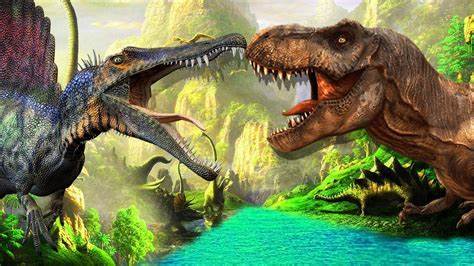We all know by now that most dinosaurs were probably feathered, right?
我们都已经知道,有可能大多数恐龙都有羽毛,对吧?
I mean, since the discovery of feathered theropod dinosaur fossils in the mid-1990s,
自从上世纪90年代中期考古学家们发现了长有羽毛的兽脚类恐龙化石以来,
that’s become pretty common knowledge.
恐龙有羽毛这点基本已经成为常识了。
This year, in 2019, scientists have linked together many fossil and genetic discoveries
今年,也就是2019年,科学家们将许多化石发现与基因发现联系在了一起,
to address a long-standing question in the paleontological community.
为的便是解决古生物学界一直没有解决的一个问题。
When did feathers evolve?
那就是:动物的羽毛是什么时候进化出来的?
The conclusions could upend everything we thought we knew,
而科学家们得出的结论,可能会打破我们现有的所有认知,
not only about the evolution of feathers...but about the whole dinosaur evolutionary timeline, too.
不仅是打破我们关于羽毛进化的认知,我们对恐龙这一物种的整个进化时间线的认知也会因此颠覆。
The long-held belief has been that feathers evolved around the same time as birds,
传统的观念是羽毛的进化和鸟类的进化基本是同步的,
giving them an advantage in a dinosaur-driven world,
这样鸟类才能在恐龙主宰的世界里寸有所长,
and that dinosaurs developed feathers around the same time that birds were branching off.
而恐龙进化出羽毛的时间又跟鸟类从恐龙中分化出去的时间差不多。
But recent discoveries indicate that we may need to start thinking about this totally differently.
然而,最近的研究发现表明,我们可能需要换个方式,换个完全不一样的方式来思考这一问题。
In the early 2010’s, a fossil discovered in Russia showed remarkably well-preserved skin covered in both scales and feather-like structures.
2010年代的头几年科学家们在俄罗斯发现的一块化石还带有保存非常完好的皮肤,上面还覆盖有鳞片和类似羽毛的结构。
And recently, pterosaur fossils have been found to display feathery structures too.
最近发现的翼龙化石也表现出了羽毛结构。
And pterosaurs are the flying reptilian cousins of dinosaurs.
翼龙算是恐龙在会飞的爬行动物中的同类。
And both of these organisms are quite a ways back from birds on the evolutionary tree.
而从进化史来看,这两种生物出现的时间要远早于鸟类出现的时间。
Like, we think birds probably gradually evolved in the Jurassic period, about 165-150 million years ago.
我们认为鸟类很可能是在侏罗纪时期,也就是差不多1.65亿~1.5亿年前进化出来的。
But these discoveries potentially push back the origin of feathers
而最近的这些研究可能会将羽毛进化的时间起点往前推,
tens of millions of years before Archaeopteryx, which is widely regarded as the first ‘bird’!
推到比始祖鸟,也即被人们广泛认为是“鸟类”鼻祖的动物的出现还要早出几千万年的时候!
It’s worth noting here that the ‘pterosaurs had feathers’ idea is a little controversial—
值得注意的是,“翼龙有羽毛”这一说法也有些许的争议——
some paleontologists take issue with calling these structures feathers at all.
一些古生物学家根本就不同意将这些结构称之为“羽毛”。
But many experts look at these structures, whatever they may be called, as expressions of feather-producing genes.
不过,还是有许多专家认为,这些结构,不管怎么称呼,都是育羽基因的表达。
And that’s the important part.
这才是最关键的。
See, this fossil evidence, pieced together over several years, confirms genetic work.
原来啊,考古学家们经过数年拼凑才得出的这些化石证据也是基因表达的证据。
The development of feathers in an organism is controlled by the same genetic regulatory pathways
其实,控制生物体内羽毛发育和其他动物的表皮结构,
that give rise to different surface structures in other animals, like denticles in shark skin, scales in bony fish, hair in mammals—and even teeth!
比如鲨鱼皮肤上的牙齿,硬骨鱼身上的鳞片,哺乳动物身上的毛发--甚至牙齿的其实是同一基因调控通道!

Molecular genetics analysis has revealed evidence of these genomic regulations wayyyy back in the evolutionary tree, in the Archosauria group.
分子遗传学分析已经揭示,从进化史来看,鸟类还远没有出现的时候,初龙类群中就已经出现了这些基因组调控生物特征表达的证据了。
Archosauria were the “ruling reptiles” of the late Permian period,
初龙是二叠纪晚期“爬行动物界的统治者”,
and this means that the genetic basis for feathers may have existed long before the dinosaurs and well before birds, which are the Aves group.
这就意味着,羽毛的遗传基础可能比恐龙,比鸟类(鸟纲)的出现都要早得多。
All of this put together makes for pretty compelling evidence that feathers are much more ancient than we thought.
所有这些放在一起,就构成了令人信服的证据,表明羽毛比我们以为的要古老得多。
But why?
问题是,为什么会这样?
Why did feathers evolve way back before birds started using them for flight?
为什么羽毛在鸟类开始利用它们飞行之前就已经开始进化?
There’s a couple of possibilities, but one idea is that at the end of the Permian period,
有几种可能性,其中一种认为在二叠纪末期,
when those reptile dinosaur ancestors ruled the land, there was a huge extinction event: the end-Permian mass extinction, to be exact.
也就是那些爬行的恐龙祖先统治世界的时候发生了一次巨大的灭绝事件:确切地说便是二叠纪末期的大灭绝事件。
And as organisms slowly started to recover and repopulate the land, they were different.
生物界慢开始恢复并重新在地球上繁衍时,它们和灭绝前的生物已经不一样了。
They walked upright on two legs, instead of lumbering about on four.
它们能用两条腿直立行走,而不是用四条腿吃力地走来走去了。
They had faster metabolisms and some may have even been endo-thermic, or warm-blooded.
它们新陈代谢的速度加快了,有些甚至变成了内温动物,也就是温血动物。
So to compete with our ancient mammalian ancestors (who were probably already evolving hair to stay warm and hardy),
所以,为了和我们远古的哺乳动物祖先竞争(他们很可能已经进化出能够保温和耐寒的体毛了),
dinosaurs, pterosaurs, and more started using those feather-building genes to express feather-like structures, most likely for pure insulation.
恐龙,翼龙以及其他的龙便开始使用这些育羽基因来表达类似羽毛的结构,其目的嘛很可能只是为了隔热。
Overall, this changes most of our ideas about how birds may have evolved, and what role feathers played in their divergence from dinosaurs.
总的来说,这一发现改变了我们对鸟类可能是如何进化的,以及羽毛在鸟类与恐龙的分化过程中扮演了什么角色等问题的大部分看法。
This amalgamated work leaves us with a bunch of other questions, too!
不过,这一整合工作也给我们留下了一堆问题!
Were feathers present in crocodilian ancestors?
鳄鱼的祖先有羽毛吗?
What were the other purposes of feathers in birds as birds diverged from the tree?
鸟类从进化树上分化出来的时候,羽毛还有其他哪些用途?
These radically shifting evolutionary timelines don’t just change our popular conceptions of what dinosaurs may have looked like.
这些急剧变化的进化时间线不仅改变了我们对恐龙的普遍看法。
Heck, the movies probably have bigger things to worry about.
擦嘞,电影界可能还有更重要的问题要操心。
But, emerging techniques and the melding of fossil and genetic research
不过,在新兴技术的帮助下,加上化石研究和基因研究的结合,
keep bringing us closer to a more complete picture of the evolution of life on Earth,
我们距离更深入地了解地球生命的进化,我们今天所见的那些生物体是如何形成的,
and how the organisms we recognize today came to be and are related to each other.
它们之间是如何相互关联等问题的答案也越来越近了。
If you want more fossil breakthroughs, check out this video on T Rex development here,
想了解更多化石研究方面的突破,请查看这段关于霸王龙进化的视频,
and make sure you subscribe to Seeker for all your paleontology news.
记得订阅我们的频道,全方位地了解古生物学新闻噢。
If you have another fossil mystery you like to see us uncover(very carefully, with our paleontologist’s brushes),
如果你有其他想要我们揭晓(用我们的古生物学家刷子非常仔细地揭晓)的化石之谜的话,
let us know down in the comments, and as always—thanks for watching.
请在评论中告诉我们,还是那句老话,感谢大家的收看。












